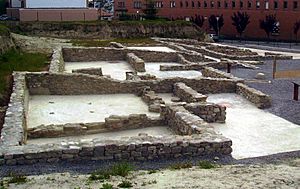El Camp de les Lloses Interpretation Centre and Site facts for kids
El Camp de les Lloses was an ancient Roman town. It was built a very long time ago, between the 2nd and 1st centuries BC. This settlement was located near where the town of Tona is today, in a region called Osona.
Discovering El Camp de les Lloses
Digging at the site started in 1915. Workers accidentally found an ancient stone marker, called an Iberian stele, in Tona. Later, in 1944, heavy rains washed away some soil. This revealed the first layers of the settlement. These layers showed buildings from the Iberian period. Another deeper layer might have had human remains from around 600 to 700 BC.
What Archaeologists Found
In the early 1990s, many more ancient structures were found across the area. Because of its importance, the site was officially named a "Cultural Heritage of National Interest" in 1995. This means it's a very special historical place for the country. From 1995 until 2006, archaeologists worked hard. They continued to dig and study the remains. They also prepared the discovered items for display in a museum.
See also
 In Spanish: El Camp de les Lloses para niños
In Spanish: El Camp de les Lloses para niños


